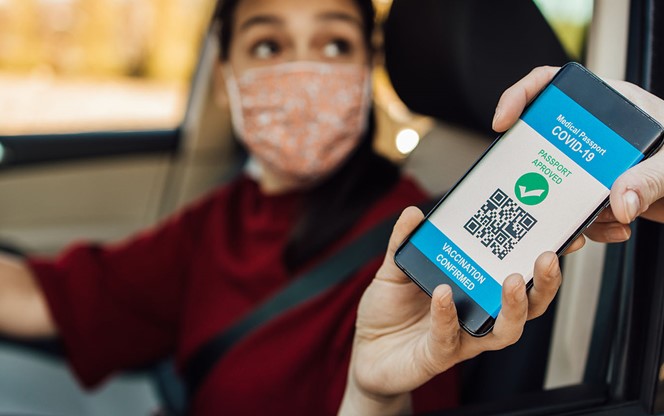

Archived Insight | November 9, 2021
Under an emergency temporary standard issued by the Occupational Safety and Health Administration (OSHA), all private sector employers that have 100 or more employees are required to ensure their workforce is fully vaccinated or require any workers who remain unvaccinated to produce a negative test result on at least a weekly basis before coming to work. This mandate also applies to local and state government employers in states that have worker safety agencies that cover public sector employees.

Share this page
The emergency temporary standard takes effect on November 5, 2021. By December 5, 2021, employers subject to the rule must give employees paid time off to get vaccinated. That is also the deadline for ensuring that unvaccinated employees wear masks at work. By January 4, 2022, workers must either be fully vaccinated or be tested at least weekly.
Several businesses and states immediately filed a lawsuit challenging the rule. On November 6, 2021, the United States Court of Appeals for the Fifth Circuit issued an order staying the rule pending further action by the court. The court ordered an accelerated schedule for the parties to file responses, so further action is likely soon. Employers should review the terms of the rule as the outcome of the litigation is unclear.
The OSHA mandate follows similar rules for federal workers and contractors. (We summarized the requirements for federal contractors in our November 2, 2021 insight.)
The emergency temporary standard (ETS), which was published in the November 5, 2021 Federal Register, requires covered employers to:
Employers with 100 or more employees are subject to the OSHA rule unless they are covered under similar rules for federal contractors, the federal workplace or a healthcare worker rule. The guidance applies to all employees except for employees who do not report to a workplace where other individuals are present, are working from home or who work exclusively outdoors.
Employees who are not fully vaccinated must be tested at least every seven days and provide testing results to the employer. Employers must maintain records of these tests.
Employees who do not provide test results may not be permitted in the workplace. Acceptable COVID-19 tests are those that are FDA-approved, including by Emergency Use Authorization, to detect current infection (antibody tests are not permitted). A test cannot be both self-administered and self-read unless observed by either the employer or an authorized telehealth proctor. Employers are not required to pay for the cost of the testing. Employees must notify the employer if they receive a positive COVID-19 test or are diagnosed with COVID-19.
Employees who are not fully vaccinated must wear a face covering when indoors or when occupying a vehicle with another person for work purposes. Face masks are not required when an employee is alone in a room with floor-to-ceiling walls and a closed door.
Employers must provide time off from work to allow employees to get vaccinated and recover from any potential side effects. The rule requires employers to provide reasonable time, including up to four hours of paid time off at the employee’s regular rate of pay, to receive each primary vaccination dose. The maximum of four hours of paid time off that employers must provide for the administration of each primary vaccination dose cannot be offset by any other leave that the employee has accrued, such as sick leave or vacation.
In addition, employers must provide reasonable time and paid sick leave to recover from side effects following each primary vaccination dose. However, employers may require employees to use paid sick leave benefits otherwise available to offset these costs.
States that have worker safety agencies can accept OSHA’s emergency temporary standard, modify it or replace it with a similar rule. The states are Alaska, Arizona, California, Connecticut, Hawaii, Illinois, Indiana, Iowa, Kentucky, Maine, Maryland, Michigan, Minnesota Nevada, New Jersey, New Mexico, New York, North Carolina, Oregon, South Carolina, Tennessee, Utah, Vermont, Virginia, Washington and Wyoming. Puerto Rico and the U.S. Virgin Islands also have worker safety agencies.
The deadline for these jurisdictions to implement a standard is December 5, 2021.
Failure to enforce the emergency temporary standard could trigger a fine for each serious violation of as much as $13,653. If OSHA determines the violation is willful, it could impose a greater fine, up to $136,532.
OSHA is interested in employers’ answers to several questions, including these:
OSHA is also seeking input on whether to apply the emergency temporary standard to smaller employers because it is not sure that employers with fewer than 100 employees have the administrative capacity to implement the standard’s requirements.
OSHA will continue to monitor trends in COVID-19 infections and death as more of the workforce and the general population become fully vaccinated against COVID-19. If it determines a grave danger from the virus no longer exists for the covered workforce or new information indicates a change in measures necessary to address the grave danger, it will update the emergency temporary standard.
On November 4, 2021, the Centers for Medicare and Medicaid Services issued an emergency regulation requiring healthcare workers at hospitals and other facilities that participate in the Medicare and Medicaid programs be vaccinated by January 4, 2022.
By December 5, 2021, facilities covered by this regulation must establish a policy ensuring all eligible staff have received the first dose of a two-dose COVID-19 vaccine or a one-dose COVID-19 vaccine prior to providing any care, treatment or other services. All eligible staff must have received the necessary shots to be fully vaccinated by January 4, 2022. The regulation also provides for exemptions based on recognized medical conditions or religious beliefs, observances or practices. This emergency regulation was also published in the November 5, 2021 Federal Register.
Employers that have at least 100 employees should ensure their COVID-19 vaccine policies and practices comply with the new OSHA emergency temporary standard or an equivalent requirement issued by a state. Employers should monitor the federal litigation concerning the rule as it may affect the terms of the rule or compliance deadlines.

Health, Compliance, Multiemployer Plans, Public Sector, Healthcare Industry, Higher Education, Architecture Engineering & Construction, COVID-19, Corporate

Health, Multiemployer Plans, Public Sector, Healthcare Industry, Higher Education, Architecture Engineering & Construction, COVID-19, Pharmaceutical, Corporate

Health, Multiemployer Plans, Public Sector, Healthcare Industry, Higher Education, Architecture Engineering & Construction, COVID-19, Pharmaceutical, Corporate, Mental Health
This page is for informational purposes only and does not constitute legal, tax or investment advice. You are encouraged to discuss the issues raised here with your legal, tax and other advisors before determining how the issues apply to your specific situations.
© 2025 by The Segal Group, Inc.Terms & Conditions Privacy Policy Style Guide California Residents Sitemap Disclosure of Compensation Required Notices